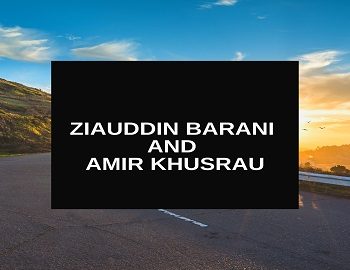Table of Contents
Ziauddin Barani and Amir Khusrau:
Ziauddin Barani:
Maulana Barani was born in 1286 in the reign of Sultan Balban. For the study of Delhi Sultanate, as literary source material, two important texts of Barani such as Tariq-i-Ferozshahi and Fatwa-i-Jahandari are having the greater importance. It is said that where Tabakat-i-Nashri of Minhas-u-Siraj has ended Tariq-i-Ferozshahi of Barani started. This text of Barani throws light on the period between Balban and Muhammad-bin-Tughlaq.
Barani was having a different conception and ideal of history writing. He takes history as a religious work so he was suffering from some sense of guilt because he is grieved at the fact that he could not oppose Muhammad-bin-Tughlaq when Muhammad-bin-Tughlaq took an anti-religious step. This is the reason he appears to be a bit of critique of Muhammad-bin-Tughlaq.
Unlike Minhas-u-Siraj, he separated the history of India from that of Central Asia. Sometimes we find the writing of Barani is very orthodox with a strong anti-Hindu tinge but when we observe minutely, we find that actually, the dissatisfaction of Barani just reflected the conflict between Hindu and Muslim nobility.
Limitation: We underline some limitations as well in the account of Barani. Firstly, he is much careless about the dates and chronology of events. Secondly, sometimes he appears to be too much prejudiced.
Conclusion: But in spite of the limitations mentioned above, the accounts of Barani is important source material for the study of Delhi Sultanate. From the writings of Barani, we not only get the information about administrative and economic affairs but also we get the reflection of the intellectual development of society.
Amir Khusrau:
Mhusrau was born in 1252 in a Turkish family at Patiyali in the Etah district of Uttar Pradesh. His full name was Abul Hassan Yaminuddin Khusrau. He is popularly known by his pseudonym of Amir Khusrau. He was a disciple of the famous Sufi Saint Nizamuddin Auliya. He was a noted scholar during the period of Delhi Sultanate. But he was basically a literary person rather than a historian. Still, his text appeared to be important source material for the study of this period. He decorated the court of seven sultans and his text throw light on the period between Bughra Khan and Giyassudin Tughlaq. Some of his important texts are such as Kirana-ul-Sadain, Mifta-ul-Futuh, Khazayan-ul-Futu, Nuh Sipihar, Tughlaqnama, Ashiqa and Aizaj-i-Khushravi.
As he was basically a literary person, so his writing is chaste and ornate. He presents a very lively picture of the social and cultural history of his time. Even the political events described by him appeared to be authentic. For example, he threw light on the battle between Kushro Shah and Gaji Malik. Unlike Barani, he is careful about the dates and chronology. His dates and chronology appeared to be authentic.
Limitations: But still as a historian he is having some definite limitations. Firstly, he did not select his subjects for writing independently, but rather he was given the assignment to write on the subjects. So, sometimes his writing appears to be a piece of flattery meant for satisfying his master.
In order to put his name in the good look of his master he simply dropped some episodes which could be disturbing to his master. For example- the episode pertaining to the assassination of Jalaluddin Khalji by Alauddin Khalji.
Conclusion: But in spite of the limitations mentioned above the writing of Amir Khusro remains to be an important source material for the study of social, cultural and political history of Delhi Sultanate. His extra sensibility as a literary person infused a new life in his history writing.









Comments (No)